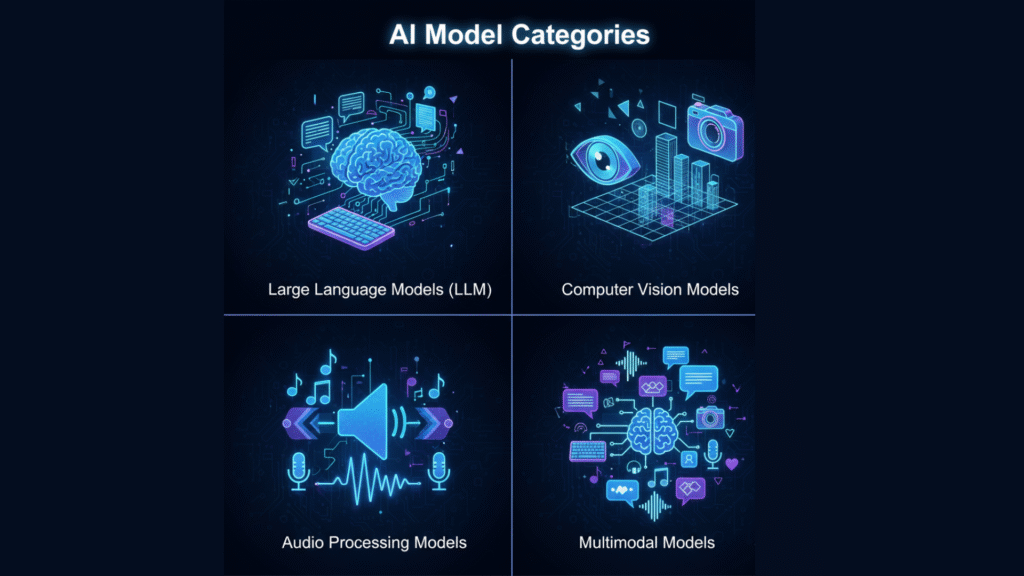The artificial intelligence landscape offers an overwhelming array of models, each optimized for different tasks, data types, and performance requirements. Strategic AI model selection has become critical for maximizing performance while controlling costs, as organizations discover that using the wrong model for specific tasks can result in 40% lower accuracy and 60% higher operational expenses compared to optimal model choices. The challenge isn’t just identifying capable AI models—it’s matching the right model capabilities with specific business requirements and workflow constraints.
Understanding how to evaluate, compare, and select AI models for different use cases ensures organizations achieve optimal performance while avoiding vendor lock-in and excessive costs that plague poorly planned AI implementations.
The Complexity of Modern AI Model Selection
Today’s AI ecosystem includes hundreds of specialized models designed for specific tasks, data types, and performance requirements. From large language models optimized for creative writing to computer vision models designed for medical imaging, the specialization has created both opportunities and selection challenges for business users.
Key Selection Dimensions
- Task Specialization: Different models excel at content generation, data analysis, image processing, or conversation
- Performance Requirements: Speed, accuracy, and resource consumption vary dramatically across models
- Data Type Compatibility: Text, image, video, audio, and multimodal processing capabilities
- Cost Structure: Usage-based pricing, subscription models, and computational resource requirements
Understanding AI Model Categories

Effective model selection requires understanding the strengths and limitations of different AI model categories and how they align with specific business applications and technical requirements.
Large Language Models (LLMs)
- Strengths: Exceptional text generation, analysis, and conversational capabilities
- Optimal Use Cases: Content creation, customer service, document analysis, and strategic planning
- Considerations: High computational costs for complex tasks, potential for inconsistent outputs
Computer Vision Models
- Strengths: Image recognition, object detection, and visual content analysis
- Optimal Use Cases: Product catalog management, quality control, medical imaging, and visual content moderation
- Considerations: Require high-quality training data, performance varies significantly with image conditions
Audio Processing Models
- Strengths: Speech recognition, audio generation, and sound analysis
- Optimal Use Cases: Transcription services, voice interfaces, podcast production, and accessibility applications
- Considerations: Performance depends heavily on audio quality and language complexity
Multimodal Models
- Strengths: Process multiple data types simultaneously for comprehensive analysis
- Optimal Use Cases: Complex content analysis, cross-modal search, and integrated workflow automation
- Considerations: Higher computational requirements, more complex integration challenges
Task-Specific Selection Criteria

Different business applications require different model characteristics that prioritize accuracy, speed, cost efficiency, or specialized capabilities based on specific use case requirements and organizational constraints.
Content Creation and Marketing
- Primary Requirements: Creativity, brand voice consistency, and output variety
- Model Characteristics: Strong language understanding, style adaptation, and creative capabilities
- Performance Metrics: Content quality, brand alignment, and generation speed
Data Analysis and Business Intelligence
- Primary Requirements: Accuracy, reasoning capabilities, and structured output generation
- Model Characteristics: Strong analytical reasoning, numerical processing, and pattern recognition
- Performance Metrics: Analysis accuracy, insight relevance, and processing efficiency
Customer Service and Support
- Primary Requirements: Conversational abilities, context retention, and empathetic responses
- Model Characteristics: Strong dialogue management, emotional understanding, and knowledge retrieval
- Performance Metrics: Response accuracy, customer satisfaction, and resolution rates
Process Automation
- Primary Requirements: Reliability, consistency, and integration capabilities
- Model Characteristics: Stable performance, structured outputs, and API compatibility
- Performance Metrics: Error rates, processing speed, and system reliability
Performance vs. Cost Optimization

Model selection requires balancing performance requirements with budget constraints while considering long-term scaling costs and operational complexity that impact total cost of ownership.
Cost Structure Analysis
- Usage-Based Models: Pay per API call or processing unit, ideal for variable workloads
- Subscription Models: Fixed monthly costs, better for predictable high-volume usage
- Self-Hosted Options: Higher upfront costs but lower long-term expenses for large-scale implementations
Performance Trade-Offs
- Speed vs. Accuracy: Faster models often sacrifice some accuracy for improved response times
- Capability vs. Cost: More sophisticated models typically require higher computational resources
- Specialization vs. Flexibility: Task-specific models often outperform general-purpose alternatives
Model Evaluation and Testing Frameworks
Systematic model evaluation ensures optimal selection based on actual performance with real business data rather than theoretical capabilities or marketing claims from AI providers.
Evaluation Methodology
- Benchmark Testing: Compare models using standardized tests relevant to specific use cases
- A/B Testing: Run parallel implementations to measure performance differences with actual business data
- Cost-Benefit Analysis: Calculate total cost of ownership including implementation, usage, and maintenance expenses
Key Performance Metrics
- Accuracy Measurements: Task-specific accuracy metrics that align with business objectives
- Latency Analysis: Response times under various load conditions and data complexity levels
- Resource Utilization: Computational requirements and infrastructure implications
- Integration Complexity: Technical difficulty and time requirements for implementation
Future-Proofing Model Selection
AI technology evolves rapidly, requiring selection strategies that accommodate model improvements, new capabilities, and changing business requirements without requiring complete system overhauls.
Flexibility Considerations
- Model Agnostic Architectures: Systems that can switch between different models without major redesign
- API Standardization: Integration approaches that minimize vendor lock-in and enable model updates
- Performance Monitoring: Continuous evaluation systems that identify when model upgrades provide value
Qolaba AI: Model-Agnostic Excellence
Qolaba AI’s access to 60+ specialized AI models across text, image, video, and speech processing eliminates the challenge of model selection by providing the best AI for every specific task within a single platform. Instead of committing to one model provider or capability set, teams can leverage cutting-edge models from multiple providers, automatically routing each task to the optimal AI model for superior results.
The model-agnostic approach ensures organizations always have access to the latest AI capabilities without vendor lock-in, while the unified workspace eliminates the complexity of managing multiple AI subscriptions and integrations. The credit-based pricing scales naturally with actual usage across all models, making it cost-effective to access premium AI capabilities without over-committing to specific model types or providers.
Implementation Strategy and Best Practices
Successful AI model selection requires systematic implementation that begins with pilot testing, scales based on proven performance, and maintains flexibility for future optimization and model updates.
Organizations achieve optimal results by starting with clearly defined use cases, implementing comprehensive testing frameworks, and building model selection capabilities that evolve with advancing AI technology and changing business requirements.
Ready to access 60+ specialized AI models and eliminate model selection complexity? Discover Qolaba AI’s model-agnostic platform and leverage the best AI for every task without vendor lock-in or integration complexity.





